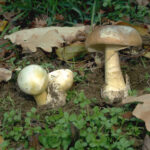The Food Safety Learning Centre provides a link for educators and the community to access resources to help learn more about food safety. There is also more information on our member the Australian Institute of Food Science and Technology’s Australian Agrifood Science Portal
Meet the bugs – what are the bacteria and viruses that cause foodborne disease
 Food isn’t sterile; it comes from animals or grows in soil. If we are healthy adults, our immune systems can deal with small numbers of bacteria and viruses but at higher levels they can make us quite sick. Vulnerable people such as pregnant women, the elderly or people with poor immune systems can get very ill or even die from food poisoning.
Food isn’t sterile; it comes from animals or grows in soil. If we are healthy adults, our immune systems can deal with small numbers of bacteria and viruses but at higher levels they can make us quite sick. Vulnerable people such as pregnant women, the elderly or people with poor immune systems can get very ill or even die from food poisoning.
Food poisoning is more frequently caused by bacteria. Bacteria like to grow in the ‘temperature danger zone’ between 5°C and 60°C. Their numbers can double and redouble and in a few hours they can reach dangerous levels.
Some viruses that cause foodborne disease include Hepatitis A, Norwalk virus, Norovirus, Rotavirus and some of the Caliciviruses. Viruses don’t grow in food, and one particle may be enough to make you sick.
Bacillus cereus and other Bacillus species
Campylobacter
Clostridium botulinum
Clostridium perfringens
Coronavirus (COVID-19) and food
Escherichia coli (E.coli)
Listeria monocytogenes
Salmonella
Staphylococcus aureus
Viruses (Hepatitis A, Norovirus and Rotovirus)
What is foodborne disease?
Common symptoms of foodborne diseases can be mild or severe and can include:
- nausea
- vomiting
- diarrhoea
- stomach cramps
- headaches
- fever
Generally the illness only lasts one or two days. Exceptions are Hepatitis A, some Escherichia coli infections or typhoid which can be severe illnesses lasting for many weeks. Some foodborne illnesses can result in long term health issues involving the immune system, the gut or kidneys as described below.
Here is advice on What to do if you get food poisoning.
How to reduce your risk of getting food poisoning
Clean
Clean hands will decrease the possibility of food poisoning and other diseases markedly. Remember the 20/20 rule: wash hands for 20 seconds with warm soapy water dry hands for 20 seconds before starting to cook repeat frequently especially after handling raw meats, or vegetables with visible soil. Wash utensils and cutting boards with soap and warm water, and dry thoroughly, before handling different sorts of foods.This is particularly important when dealing with raw meats and vegetables.
Have fun learning to wash your hands – our member OnSolution has the amazing Glitterbug that uses UV light to show how well you’ve washed your hands – great for kids and adults too find out more
Chill
As soon as possible after purchase meat, poultry, dairy foods, vegetables, salad ingredients, etc should be refrigerated at or below 5ºC. Sounds easy but often food is left in hot cars or put in refrigerators that are not cold enough. A fridge thermometer should be used to make sure the temperature is at or below 5ºC. The temperature should be adjusted in line with changing seasons and the amount stored. Refrigerate leftovers promptly. Cooked food should be stored in covered containers and either put in the fridge to cool, or frozen immediately. Frozen foods should be defrosted in the fridge NOT on the kitchen bench. If in doubt, throw it out!
Cook
Cook chicken, minced or boned meats, hamburger, stuffed meats and sausages right through until they reach 75°C using a meat thermometer. Serve hot food steaming hot above 60ºC. Defrost frozen poultry and rolled and stuffed meats thoroughly before cooking. Always follow cooking instructions on packaged foods.
Separate
To avoid cross contamination keep raw and cooked foods separate when storing and preparing. Food should be stored in covered containers in the fridge and put raw meats and poultry in the bottom of the fridge so the juices don’t contaminate food on lower shelves. Don’t put cooked meat back on the plate the raw meat was on.
Interested in learning more about food safety?
 We have partnered with our member Highfield e-learning to make online food safety basic training courses affordable and available as well as meeting our long term aim of getting course material into schools. Highfield e-learning will be making a charitable donation of 10% of course sales to the Food Safety Information Council to help us keep our important work going. Find out more
We have partnered with our member Highfield e-learning to make online food safety basic training courses affordable and available as well as meeting our long term aim of getting course material into schools. Highfield e-learning will be making a charitable donation of 10% of course sales to the Food Safety Information Council to help us keep our important work going. Find out more
Watch our simple videos on food safety advice on YouTube
School canteen free poster
We have partnered with our supporter Provisual to get handwashing and other food safety information into school canteens and tuckshops and we also encourage all schools to order Provisual’s free canteen posters from here.
We also have a range of educational resources you can download and print out including:
![]()
How to wash your hands properly (adult poster) download
![]()
How to wash your hands properly – kids’ version download
![]()
Download our ‘is it done yet?’ infographic
![]()




